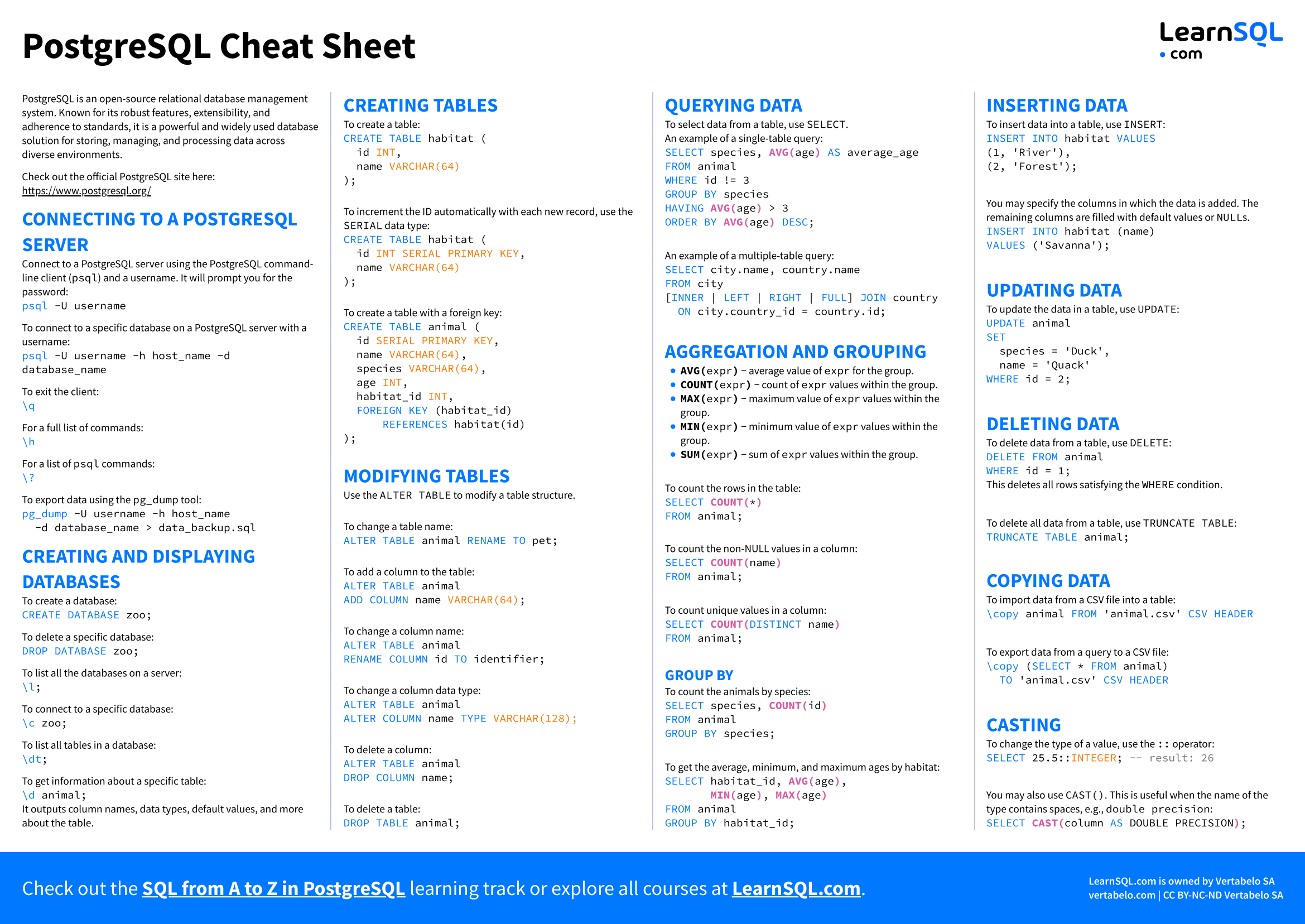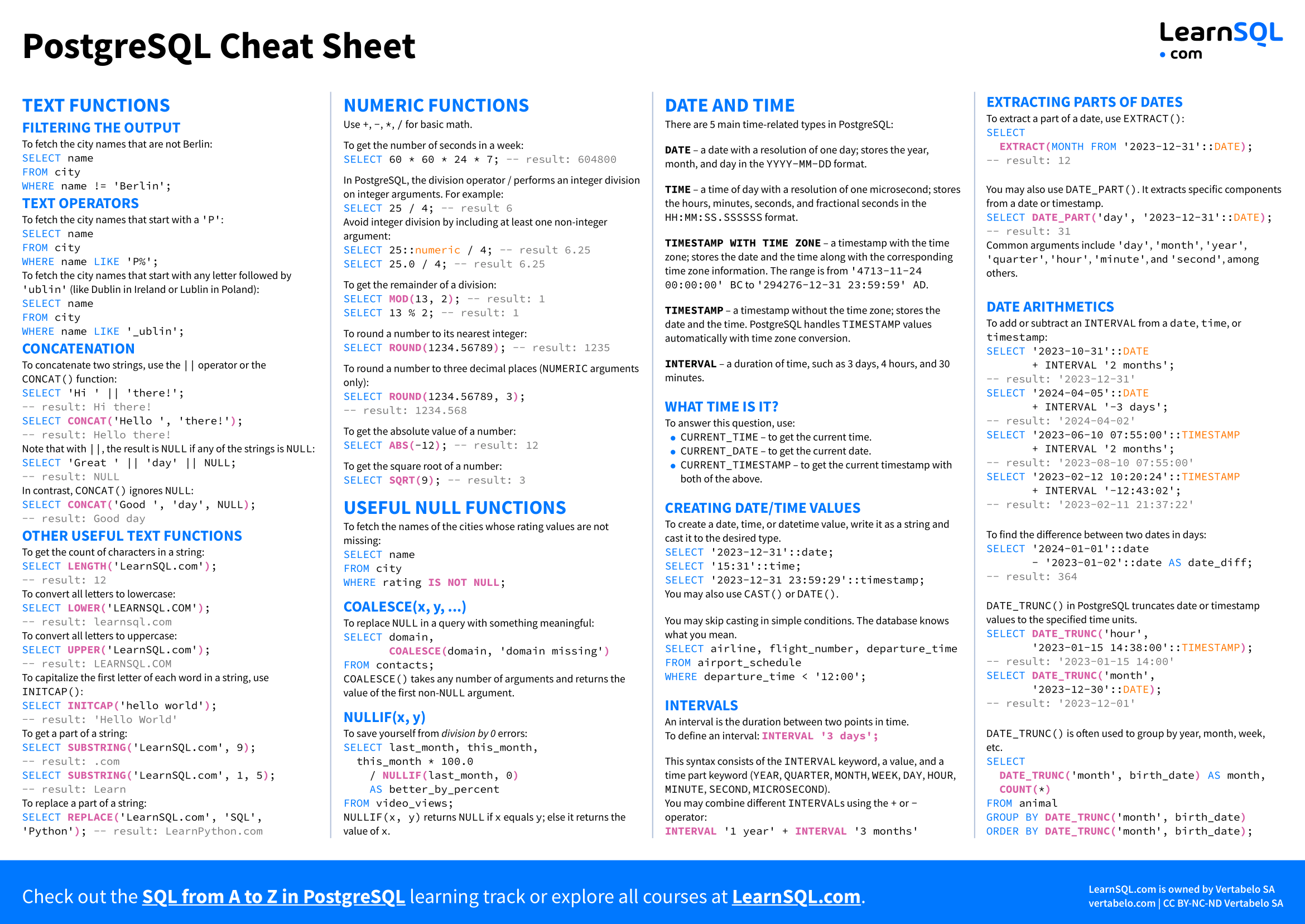
You can also download the cheat sheet in high-resolution PNG format, perfect for quick online reference or sharing on social platforms. To download, right-click (for desktop users) or long tap (for mobile users) on the image.


PostgreSQL is an open-source relational database management system. Known for its robust features, extensibility, and adherence to standards, it is a powerful and widely used database solution for storing, managing, and processing data across diverse environments.
Check out the official PostgreSQL site here: https://www.postgresql.org/
The complete learning path for PostgreSQL. Try out our SQL from A to Z in PostgreSQL track. 7 hands-on PostgreSQL courses with over 800 exercises!
Connect to a PostgreSQL server using the PostgreSQL command-line client ( psql ) and a username. It will prompt you for the password:
psql -U username
To connect to a specific database on a PostgreSQL server with a username:
psql -U username -h host_name -d database_name
To exit the client:
For a full list of commands:
For a list of psql commands:
To export data using the pg_dump tool:
pg_dump -U username -h host_name -d database_name > data_backup.sql
To create a database:
CREATE DATABASE zoo;
To delete a specific database:
DROP DATABASE zoo;
To list all the databases on a server:
To connect to a specific database:
\c zoo;
To list all tables in a database:
To get information about a specific table:
\d animal;
It outputs column names, data types, default values, and more about the table.
To create a table:
CREATE TABLE habitat ( idINT , nameVARCHAR(64) );
To increment the ID automatically with each new record, use the SERIAL data type:
CREATE TABLE habitat ( idINT SERIAL PRIMARY KEY , nameVARCHAR(64) );
To create a table with a foreign key:
CREATE TABLE animal ( idSERIAL PRIMARY KEY , nameVARCHAR(64) , speciesVARCHAR(64) , ageINT , habitat_idINT ,FOREIGN KEY (habitat_id)REFERENCES habitat(id) );
Use the ALTER TABLE to modify a table structure.
To change a table name:
ALTER TABLE animalRENAME TO pet;
To add a column to the table:
ALTER TABLE animalADD COLUMN nameVARCHAR(64) ;
To change a column name:
ALTER TABLE animalRENAME COLUMN idTO identifier;
To change a column data type:
ALTER TABLE animalALTER COLUMN nameTYPE VARCHAR(128);
To delete a column:
ALTER TABLE animalDROP COLUMN name;
To delete a table:
DROP TABLE animal;
To select data from a table, use SELECT .
Learn to query data in PostgreSQL by actually writing code. Complete 130 interactive exercises in our SQL Basics in PostgreSQL course and gain confidence in your coding skills.
An example of a single-table query:
SELECT species,AVG( age) AS average_ageFROM animalWHERE id != 3GROUP BY speciesHAVING AVG( age) > 3ORDER BY AVG( age) DESC ;
An example of a multiple-table query:
SELECT city.name, country.nameFROM city [INNER |LEFT |RIGHT |FULL ]JOIN countryON city.country_id = country.id;
To insert data into a table, use INSERT :
INSERT INTO habitatVALUES
(1, 'River'),
(2, 'Forest');
You may specify the columns in which the data is added. The remaining columns are filled with default values or NULL s.
INSERT INTO habitat (name)VALUES ('Savanna');
To update the data in a table, use UPDATE :
UPDATE animalSET
species = 'Duck',
name = 'Quack'WHERE data
To delete data from a table, use DELETE :
DELETE FROM animalWHERE >This deletes all rows satisfying the WHERE condition.
To delete all data from a table, use TRUNCATE TABLE :
TRUNCATE TABLE animal;
To count the rows in the table:
SELECT COUNT( *) FROM animal;
To count the non-NULL values in a column:
SELECT COUNT( name) FROM animal;
To count unique values in a column:
SELECT COUNT( DISTINCT name) FROM animal;
To count the animals by species:
SELECT species,COUNT( id) FROM animalGROUP BY species;
To get the average, minimum, and maximum ages by habitat:
SELECT habitat_id,AVG( age) ,MIN( age) ,MAX( age) FROM animalGROUP BY habitat_id;
To import data from a CSV file into a table:
\copy animalFROM 'animal.csv'CSV HEADER
To export data from a query to a CSV file:
\copy (SELECT *FROM animal)TO 'animal.csv'CSV HEADER
To change the type of a value, use the :: operator:
SELECT 25.5::INTEGER ;-- result: 26
You may also use CAST() . This is useful when the name of the type contains spaces, e.g., double precision :
SELECT CAST( columnAS DOUBLE PRECISION) ;
To fetch the city names that are not Berlin:
SELECT nameFROM cityWHERE name != 'Berlin';
To fetch the city names that start with a 'P' :
SELECT nameFROM cityWHERE nameLIKE 'P%';
To fetch the city names that start with any letter followed by 'ublin' (like Dublin in Ireland or Lublin in Poland):
SELECT nameFROM cityWHERE nameLIKE '_ublin';
To concatenate two strings, use the || operator or the CONCAT() function:
SELECT 'Hi ' || 'there!';-- result: Hi there!
SELECT CONCAT( 'Hello ', 'there!') ;-- result: Hello there!
Note that with || , the result is NULL if any of the strings is NULL :
SELECT 'Great ' || 'day' || NULL;-- result: NULL
In contrast, CONCAT() ignores NULL :
SELECT CONCAT( 'Good ', 'day', NULL) ;-- result: Good day
To get the count of characters in a string:
SELECT LENGTH( 'LearnSQL.com') ;-- result: 12
To convert all letters to lowercase:
SELECT LOWER( 'LEARNSQL.COM') ;-- result: learnsql.com
To convert all letters to uppercase:
SELECT UPPER( 'LearnSQL.com') ;-- result: LEARNSQL.COM
To capitalize the first letter of each word in a string, use INITCAP() :
SELECT INITCAP( 'hello world') ;-- result: 'Hello World'
To get a part of a string:
SELECT SUBSTRING( 'LearnSQL.com', 9) ;-- result: .com
SELECT SUBSTRING( 'LearnSQL.com', 1, 5) ;-- result: Learn
To replace a part of a string:
SELECT REPLACE( 'LearnSQL.com', 'SQL', 'Python') ;-- result: LearnPython.com
The best place to master PostgreSQL functions is our Common Functions in PostgreSQL interactive course.
Use + , - , * , / for basic math.
To get the number of seconds in a week:
SELECT 60 * 60 * 24 * 7;-- result: 604800
In PostgreSQL, the division operator / performs an integer division on integer arguments. For example:
SELECT 25 / 4;-- result 6
Avoid integer division by including at least one non-integer argument:
SELECT 25::numeric / 4;-- result 6.25
SELECT 25.0 / 4;-- result 6.25
To get the remainder of a division:
SELECT MOD( 13, 2) ;-- result: 1
SELECT 13 % 2;-- result: 1
To round a number to its nearest integer:
SELECT ROUND( 1234.56789) ;-- result: 1235
To round a number to three decimal places ( NUMERIC arguments only):
SELECT ROUND( 1234.56789, 3) ;-- result: 1234.568
To get the absolute value of a number:
SELECT ABS( -12) ;-- result: 12
To get the square root of a number:
SELECT SQRT( 9) ;-- result: 3
To fetch the names of the cities whose rating values are not missing:
SELECT nameFROM cityWHERE ratingIS NOT NULL ;
To replace NULL in a query with something meaningful:
SELECT domain,COALESCE( domain, 'domain missing') FROM contacts;
COALESCE() takes any number of arguments and returns the value of the first non- NULL argument.
To save yourself from division by 0 errors:
SELECT last_month, this_month, this_month * 100.0 /NULLIF( last_month, 0) AS better_by_percentFROM video_views;
NULLIF(x, y) returns NULL if x equals y ; else it returns the value of x .
There are 5 main time-related types in PostgreSQL:
The best place to master PostgreSQL functions is our Common Functions in PostgreSQL interactive course.
To answer this question, use:
To create a date, time, or datetime value, write it as a string and cast it to the desired type.
SELECT '2023-12-31'::date;
SELECT '15:31'::time;
SELECT '2023-12-31 23:59:29'::timestamp;
You may also use CAST() or DATE() .
You may skip casting in simple conditions. The database knows what you mean.
SELECT airline, flight_number, departure_timeFROM airport_scheduleWHERE departure_time < '12:00';
An interval is the duration between two points in time.
To define an interval:
INTERVAL '3 days'
This syntax consists of the INTERVAL keyword, a value, and a time part keyword ( YEAR , QUARTER , MONTH , WEEK , DAY , HOUR , MINUTE , SECOND , MICROSECOND ).
You may combine different INTERVAL s using the + or - operator:
INTERVAL '1 year' +INTERVAL '3 months'
To extract a part of a date, use EXTRACT() :
SELECT EXTRACT( MONTH FROM '2023-12-31'::DATE ) ;-- result: 12
You may also use DATE_PART() . It extracts specific components from a date or timestamp.
SELECT DATE_PART( 'day', '2023-12-31'::DATE ) ;-- result: 31
Common arguments include 'day' , 'month' , 'year' , 'quarter' , 'hour' , 'minute' , and 'second' , among others.
To add or subtract an INTERVAL from a date , time , or timestamp :
SELECT '2023-10-31'::DATE + INTERVAL '2 months';-- result: '2023-12-31' SELECT '2024-04-05'::DATE + INTERVAL '-3 days';-- result: '2024-04-02' SELECT '2023-06-10 07:55:00'::TIMESTAMP + INTERVAL '2 months';-- result: '2023-08-10 07:55:00' SELECT '2023-02-12 10:20:24'::TIMESTAMP + INTERVAL '-12:43:02';-- result: '2023-02-11 21:37:22'
To find the difference between two dates in days:
SELECT '2024-01-01'::date - '2023-01-02'::dateAS date_diff;-- result: 364
DATE_TRUNC() in PostgreSQL truncates date or timestamp values to the specified time units.
SELECT DATE_TRUNC( 'hour', '2023-01-15 14:38:00'::TIMESTAMP ) ;-- result: '2023-01-15 14:00' SELECT DATE_TRUNC( 'month', '2023-12-30'::DATE ) ;-- result: '2023-12-01'
DATE_TRUNC() is often used to group by year, month, week, etc.
SELECT DATE_TRUNC( 'month', birth_date) AS month,COUNT( *) FROM animalGROUP BY DATE_TRUNC( 'month', birth_date) ORDER BY DATE_TRUNC( 'month', birth_date) ;